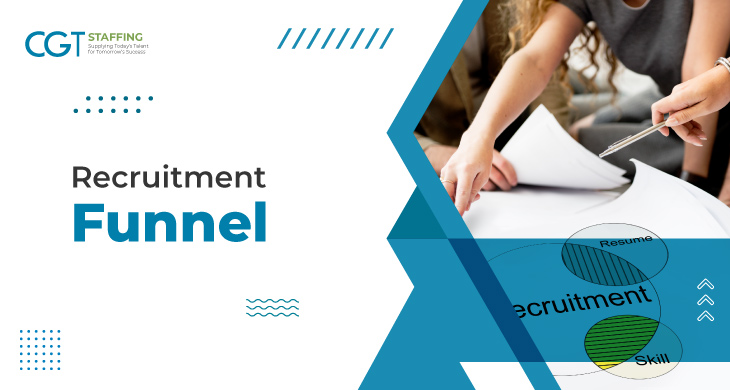In the dynamic realm of talent acquisition, building a robust recruitment strategy is akin to crafting a fine-tuned symphony. Just as a conductor orchestrates each instrument to create a harmonious melody, recruiters must navigate through various stages of a recruitment funnel to identify, engage, and ultimately, secure the best candidates. Let’s dive into the intricate journey of talent acquisition, exploring the stages that compose an effective recruitment funnel.
Table of Contents
Attraction: The Prelude to Talent Discovery
Picture this: Your company is the star of the show, and the attraction stage sets the tone for your recruitment melody. Here, the goal is to cast a wide net, enticing potential candidates to take a closer look at what your organization has to offer.
Engaging job descriptions, captivating employer branding, and strategic outreach initiatives like approaching a staffing agency, are key instruments in this phase. Imagine your job description as a captivating overture, inviting candidates to step onto the stage of possibilities. Proactive engagement on social media, targeted advertising, and participation in industry events amplify the resonance of your employer brand.
Application: The Initial Crescendo of Interest
As the curtain rises, candidates move from the audience to the stage, expressing their interest by submitting applications. The application stage is a pivotal crescendo, marking the transition from passive interest to active pursuit.
Ensure your application process is a seamless experience, akin to a smooth musical transition. Lengthy and convoluted forms can be a dissonant note, deterring potential talents. Tailor your application process to be user-friendly, asking for essential information without overwhelming candidates. A personalized acknowledgment of their application adds a warm touch, resonating positively with potential hires.
Screening: Fine-Tuning the Harmony
With applications flooding in, it’s time for the screening stage, where recruiters play the role of discerning conductors, filtering out candidates who align with the company’s tune. Screening involves a meticulous evaluation of resumes, cover letters, and initial assessments. The recruiter will have to sift through to find the best long-term employee or contingent worker.
Integrating technology, such as applicant tracking systems, into this process streamlines the screening phase. Personalization remains paramount, as candidates appreciate tailored communication. Transparent feedback, even at this early stage, adds a touch of authenticity to your recruitment composition, keeping candidates engaged in the melody.
Assessment: Orchestrating a Thorough Evaluation
Now, it’s time to bring in the instruments for a more detailed examination. The assessment stage is the symphony’s core, where candidates showcase their skills and competencies. This can involve various methods, from technical tests and case studies to psychometric assessments.
As a conductor meticulously selects the instruments that complement each other, recruiters must carefully curate assessments tailored to the role. Real-world scenarios and practical evaluations provide a glimpse of a candidate’s ability to harmonize with the company’s goals. Constructive feedback further refines the recruitment melody, guiding candidates toward improvement.
Interview: The Melodic Dialogue
The final interview stage is where the true dialogue between the company and the candidate unfolds. Think of it as a musical duet, with both parties contributing to the harmony. Face-to-face or virtual interviews offer an opportunity for a more nuanced exploration of a candidate’s suitability for the role.
Recruiters should approach interviews as collaborative sessions, delving into a candidate’s experiences, motivations, and cultural alignment. Interactive discussions create a harmonious exchange of ideas, providing insights beyond what a resume can convey. A well-balanced interview ensures that both the company and the candidate are in sync, resonating with shared goals.
The organization should ensure that the right questions are asked for the right position, including thoughtful executive interview questions that delve into leadership skills, strategic thinking, and vision for the role. This careful consideration enhances the overall rhythm of the hiring process, fostering a deeper understanding of the candidate’s potential impact on the organization.
Decision: The Climactic Crescendo
As the final notes approach, the decision stage emerges as the climactic crescendo of the recruitment symphony. Recruiters, akin to conductors, must make choices that align with the overall composition of the team.
Offering timely and personalized feedback to candidates is crucial, regardless of the outcome. Just as a well-conducted performance leaves the audience with a lasting impression, a positive candidate experience, even in rejection, enhances your employer brand. Successful candidates transition seamlessly to the next movement, ready to contribute their unique notes to the organizational melody. make sure to gather employee feedback on the process so far to gain useful insight into the effectiveness of the process.
Onboarding: Harmonizing the New Voices
The recruitment symphony doesn’t conclude with the decision stage; it extends to the onboarding phase, where new hires integrate seamlessly into the ensemble. Effective onboarding is the key to ensuring that the new voices resonate in harmony with the existing team.
Personalized onboarding plans, compliance training programs, mentorship programs, and comprehensive introductions to the organizational culture help new hires find their rhythm. An inclusive onboarding process ensures that each team member understands their role, fostering collaboration and contributing to the overall success of the organization’s melody.
In the grand finale of talent acquisition, the recruitment funnel stages blend, creating a harmonious composition. Just as a conductor molds individual notes into a cohesive piece of music, recruiters guide candidates through a transformative journey, ultimately crafting a team that produces a symphony of success.
Mastering the art of navigating these stages ensures that your organization’s talent acquisition melody continues to resonate, captivating both current and potential team members.
